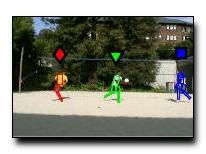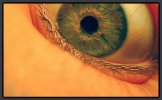
We describe a tracker that can track moving people in long sequences
without manual initialization. Moving people are modeled with the
assumption that, while configuration can vary quite substantially from
frame to frame, appearance does not. This leads to an algorithm that firstly builds a model of the
appearance of the body of each individual by clustering candidate body segments, and then uses this model to find all individuals in each frame. Unusually, the tracker does
not rely on a model of human dynamics to identify possible instances of
people; such models are unreliable, because human motion is fast and
large accelerations are common. We show our tracking algorithm can be interpreted
as a loopy inference procedure on an underlying Bayes net. Experiments on video of real scenes
demonstrate that this tracker can (a) count distinct individuals; (b)
identify and track them; (c) recover when it loses track, for example, if
individuals are occluded or briefly leave the view; (d) identify the
configuration of the body largely correctly; and (e) is not dependent on
particular models of human motion.
Download: pdf
Text Reference
Deva Ramanan and D.A. Forsyth.
Finding and tracking people from the bottom up.
In
CVPR, II: 467–474. 2003.
BibTeX Reference
@inproceedings{RamananF_CVPR_2003,
AUTHOR = "Ramanan, Deva and Forsyth, D.A.",
TAG = "people",
TITLE = "Finding and tracking people from the bottom up",
BOOKTITLE = "CVPR",
YEAR = "2003",
PAGES = "II: 467-474",
BIBSOURCE = "http://www.visionbib.com/bibliography/motion-f736.html#TT53065"
}
